Pianos are property that usually goes from one generation to the next, but when your family doesn’t have one and it comes to how to buy a used piano and what to look for, it can get a little daunting.
There are many things to check in an upright as well as a grand piano. I’ve been in that position before, so here’s what I learned when I bought the one that is sitting in my studio at this very moment.
When people ask me what to look for when buying a used piano, my answer is always the same:
Go from the outside to the inside. First, check that all the interactive pieces work well and there’s nothing in sight that is weird (keys, pedals).
Then, open the piano up and look at the internal parts to see how the hammers, bridges, strings and pins are. Finally, talk to a professional piano technician and piano tuner to see what they say. If the three stages end up with a “yes” answer, then (and only then) go for it.
So, that is the easy short answer to the initial question. There are many expensive mistakes you will want to avoid when buying a used piano, so we are about to go deep into the topic.
I’ll break down every little part in detail so you understand exactly what to look for when buying a used piano.
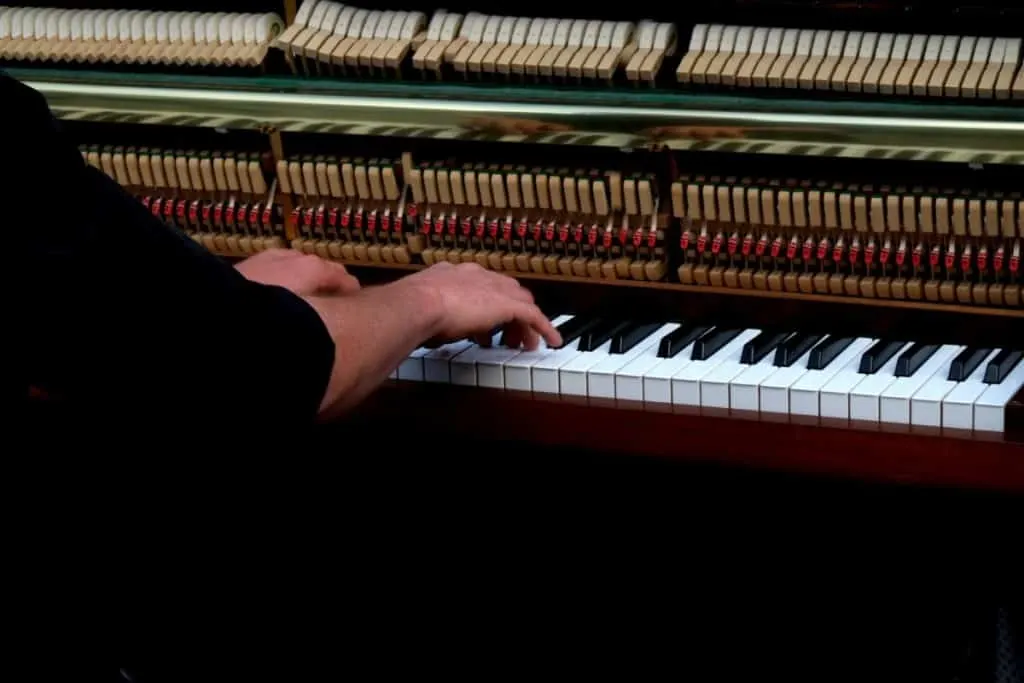
Questions You Should Ask Before Viewing A Used Piano
Before even seeing an instrument there are a lot of doubts we can clear out right away by talking to the current owner (or store clerk). Let’s take a look at the preliminary questions:
Why Are You Selling The Piano?
This is exclusive for piano owners.
You want to look for someone who is selling because they are upgrading or moving home. You should stay away (initially) from people selling because they don’t play the instrument anymore. This can translate in poor maintenance, no tuning efforts, and even rust, mold and moisture.
Who Was The Previous Owner Of The Used Piano?
This is the case of a store clerk (in case you buy used from a store). Always ask for who the previous owner was and why he or she decided to sell. Try to get as much information as possible. Piano maintenance plays a very big role in the good aging of a fine instrument.
Has The Piano Been Tuned And Maintained Regularly?
This is crucial.
An out of tune piano is not only an unplayable instrument but also an out of balance one. This is to say that true tuning stability is only a quality that pianos that spend most of their time in tune have. If the piano, on the other hand, spent most of its time out of tune, it will take more than one tuning session to get it back to normal reliable tuning.
How Long Is It Since The Piano Was Last Tuned?
The answer to this question needs to be precise.
If you want to make a car analogy we could say in car terms that it is like changing oil and filters on a regular basis, you get this little card with the date so you know you have to go a year later. With responsible owners of beautiful instruments, it should be the same.
Has The Piano Been Moved Around Much?
Another great question you should be asking.
Pianos that have been moved a lot tend to be more unstable. Let’s put it this way: a piano is a wooden instrument and wood suffers greatly from changes in temperature and humidity. Pianos that have been moved a lot tend to go through difficult acclimation periods that can leave scars behind.
There are also many great options for digital pianos available. If you are considering a digital piano you can take a look at my article on them here.
Many people also ask the question “Do digital pianos need servicing”? I have also written an article on this subject. You can read this article here
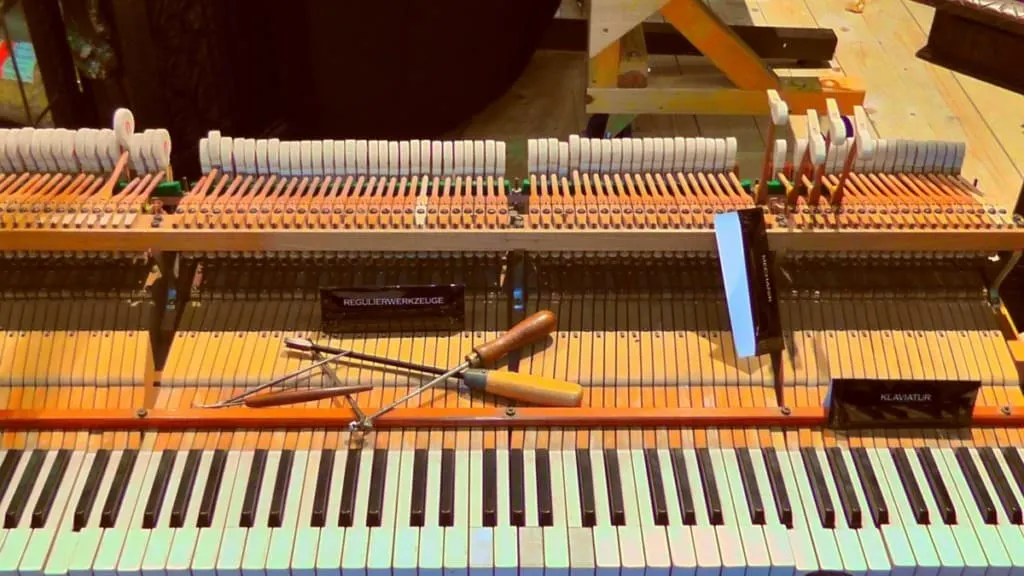
Where And How Has The Piano Been Stored?
Due to pianos being made of wood, this is yet another very important question to ask. Pianos that have been stored in storage rooms, basements, or attics without the due precautions, might have suffered some permanent damage. For example, a warped soundboard or cracked bridge due to humidity is common in pianos stored au natural not using proper methods.
“Is There Something You Want To Tell Me Upfront?”
Always give the seller a chance to be honest with you.
Using this sentence can prove to be a pressure release for those selling the instrument. Maybe you can get a sincere answer upfront and save yourself the burden of going through the insides to find out about it yourself.
Great Piano Brands To Look Out For
The equation in this field is very simple: a higher quality piano brand will use higher quality parts that ultimately translate into a better ageing instrument. You can check the big ones like Steinway & Sons (you will never go wrong with a Steinway that has been properly taken care of), Yamaha, Bösendorfer, Knabe & Co or Kawai. All these brands manufacture quality instruments.
How Old Is Too Old For Buying A Used Piano?
An extremely well taken care of instrument coming from a respectable brand with high-quality craftsmanship can exceptionally reach 100 years of good performance (with replacement parts of course).
The scenario changes dramatically for other instruments and most mass-produced pianos will work great for around 50 to 70 years with proper maintenance. If you are going to make an investment as a player, I recommend you stick to teenage pianos, preferably in their first twenty years of life.
This way you can make sure it works perfectly and with proper maintenance have a long, fruitful life of songs at your fingertips.
Piano Stool Parts To Check
Piano chairs are usually sold with them. Regardless if it is an upright piano or a grand piano, it most likely came with a matching stool. If it was stored in a home or studio where they took proper care of it, they will very likely still have the chair.
Check for the legs to match rather than the color. The original chair (regardless of the shape it is at) is always something you should ask for.
Move The Keys To The Sides
Once you are in front of the piano, rather than hit any notes, grab each key with your index finger and your thumb and move them to the sides.
Do it with black and white keys. What you are checking here is how much time do these keys have left before replacing the mechanism. If they are loose it means that they are too worn and don’t have much life left in them.
A sturdy key is always the sign of a healthy internal mechanism; aim for that at all times.
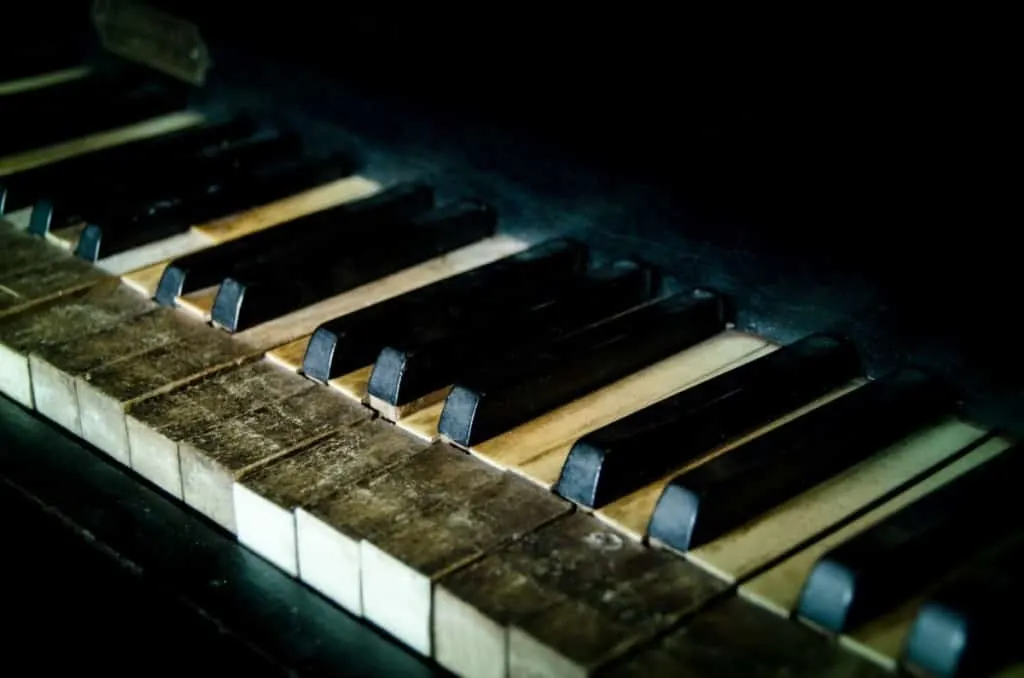
Key Discolouration On Used Pianos To Look Out For
Key discoloration is something that happens when a piano is played often but rarely cleaned.
When you check for key discoloration, you should always compare the middle to the extremes. If the extremes are perfectly white, but the center section is not, it means that it was properly played a lot for a long period of time. This is perfectly ok, just pay close attention to those keys that have lost most color and check those strings particularly.
Note Fadeaway On A Used Piano
After you have checked discoloration and sturdiness of the keys just play a note, any note in the entire piano.
The note should ring and then fade away rather elegantly, slowly going away. A nice piano that is in perfect working order will do exactly this. If the note dies very quickly after you’ve played it, then there is something out of order.
Try Every Note When Buying A Used Piano
Play every note (white and black keys) to check that all of them work.
If while you are going from bass to treble or vice versa there is only one note that is way out of tune, it might be a broken tuning peg. A broken tuning peg is not a red card; it can be fixed but should be contemplated in the final price of the instrument.
Make Sure Every Pedal Is Operating Effortlessly
Now that we have checked the outside and gone through the keys, it is time to go for the pedals. Depending on the piano and the manufacturer, you very likely have two or three pedals. The first thing you need to try is that they work flawlessly and effortlessly. Try them with your feet without playing first to see how they feel.
Used Piano Damper Pedals
Mostly, the extreme right pedal is what we call a damper pedal.
What it does is to lift every damper in the piano. Press it down and strike a major chord; everything should sound. All the notes in the piano should sound freely echoing what you have just played. There should be a difference between the sound when damped and not damped. Check for that.
Sustain Pedal
This is the second pedal that most pianos have and what it does is to obviously sustain the note we are playing. In the case, you are trying out a grand piano and this is a sostenuto or sostenuto pedal, simply strike a chord with the pedal down and play other notes.
It should sustain the chord only. If the sustain pedal mechanism works, you can simply try it in many different notes and the result will be perfect.
Take A Look Inside The Piano (the hammer mechanism)
Ok, we have made it to the part that piano owners and clerks hate a lot. This is because you have to literally take the piano apart if it is an upright one.
The machinery in charge of making the sounds happen is not in sight. When you buy a guitar, for example, you can look at tuners without much effort. Whether you buy it or not, always put it together again before leaving; be a good human.
To take a look at the mechanism in a grand piano, just lift the top cover. For upright ones you need to remove the top part and also the bottom one where you can access both sides of the mechanism. Don’t worry about dust, and dead bugs, just make sure there is nothing old, dried and rotted, no foreign objects, not too many broken hammers.
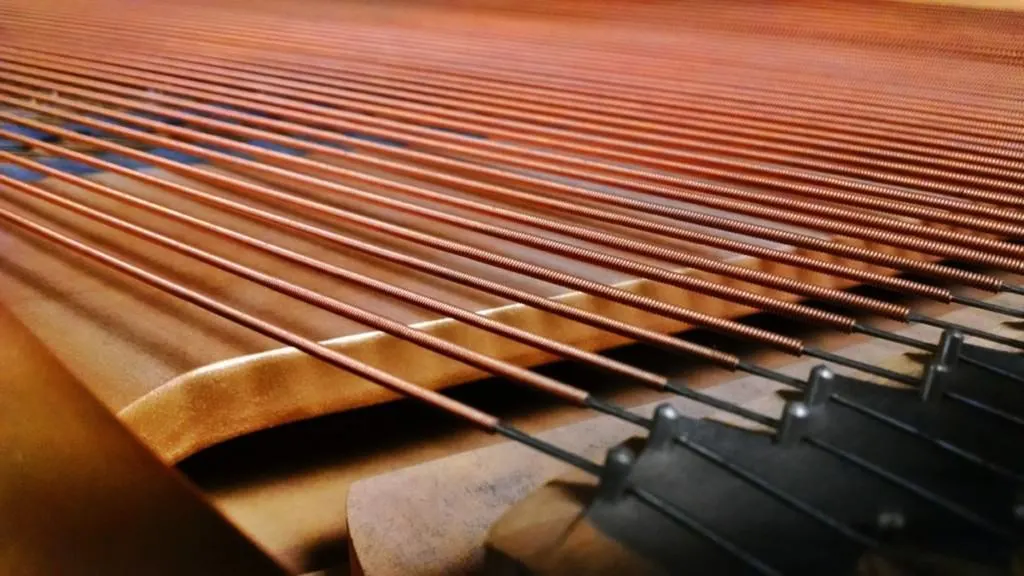
Used Piano Hammer Wear
How can you tell hammer wear? It is rather simple, just tale a close look at them or even put your finger to the surface and check for indentations in the hammer.
The repetitive action of hitting the strings can cause some deep marks in the foamy part. This translates into problems in a short amount time. Again, it’s not a red card because hammers can be replaced or reshaped. Remember about discolouration? Well, those are the first ones you have to check for indentations.
How To Check The Bottom Panel On A Used Straight Piano
Once you’ve seen the hammers on top, it is time to take a look at the rest of the machinery that hides behind the bottom panel.
Once you carefully remove it, you’ll see the treble and the bass bridges. These bridges, much like a guitar bridge, are the beginning of the sounding part of the strings. They are made of wood and it can crack with time. Check for those crackings; they are usually perpendicular to the strings.
In the case of an upright piano, the bass bridge can be fixed but the treble one goes all the way through the instrument, so it is very expensive and difficult to replace it. If the treble bridge has cracks, I would definitely walk away from it.
How To Check Cracked Soundboards On A Used Piano
Let’s say this from the start to bring down a very old myth: a cracked soundboard doesn’t make a piano useless.
How do you check if there is a crack in the soundboard? Well, if it is an upright instrument, move the piano and hold a flashlight behind the board to see cracks. If any light goes through, then it is a crack. In the case of grand pianos, you have to do the same but from the bottom to the top. You will need two people for this endeavor.
How To Check For A Warped Soundboard On A Used Piano
A warped soundboard is not as uncommon as you may think.
What can cause a soundboard (or any piece of wood) to warp? Well, simply the exposure to extreme heat, humidity, water or moisture. If this is the case, you will notice that it will be unglued from the braces. Braces can be re-glued, so this is not a red card either.
What Is A Cracked Pin Block
Pin blocks can crack with time and use. How can you check this? Well, you have to go through all the single notes. If you notice that there is one that far out of tune towards the lower registers, then check the block where that pin is at.
If the block is cracked, you’ll probably hear all the notes in the same block being just as out of tune as that one. A pin block can be fixed, but it is not a cheap repair.
How To Check Bridal Straps On A Used Piano
Bridal straps have an expiration date. It is the same as saying that you will eventually have to work on hammers, restring and retune a piano.
How do you check if the piano has broken bridal straps? First, you will notice your piano sound like The Doors on the Alabama Song. Taking a look at the inside mechanism you will clearly see differential hammer usage and this will also have an effect in the bridal straps. Remember we spoke about hammer indentation and keys discolouration? Well, this is the third symptom of the same problem.
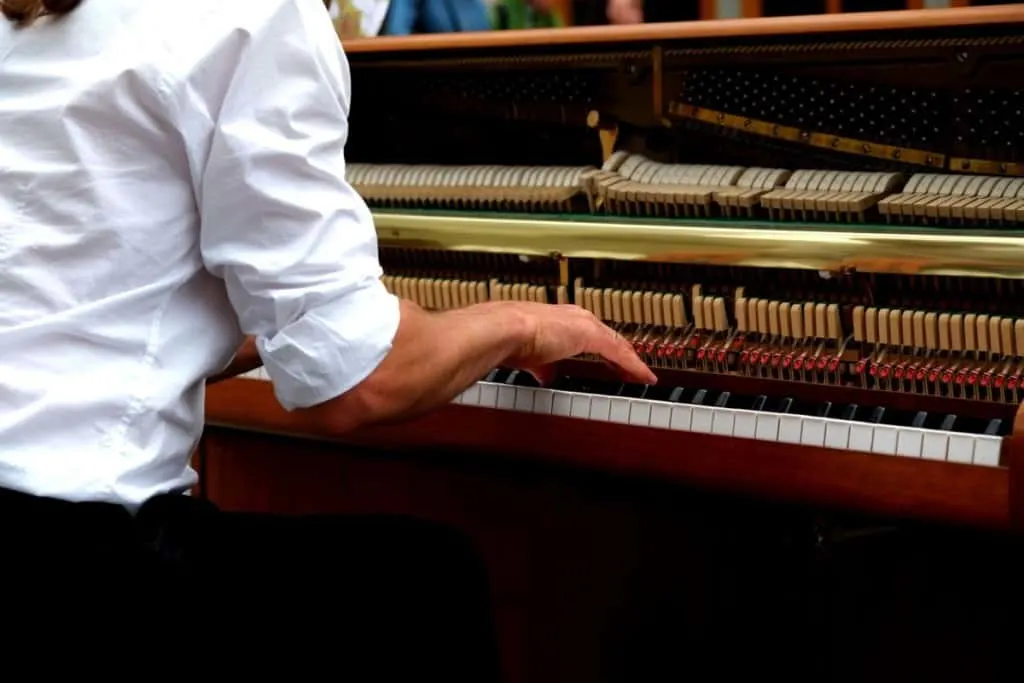
Has The Used Piano Had Any Flood Damage?
Now, this is a deal-breaker for me and it should be for you as well.
Buying a piano (upright or grand) that has gone through a flood is making a big mistake. You can work with it to make it better, but it will never play perfectly again.
Moreover, time might show more and more problems from contact with the water. What to look for to avoid buying the wrong piano? Simply look for water lines or refinished bottoms. If it smells like humidity when you open it up or see rust, or mould in the strings, warping, ungluing soundboard; it can all indicate signs of flooding.
I recommend you stay away from a piano that has gone through a flood.
Used Piano Parts That Can Be Easily Fixed Or Replaced
There are some parts in a piano that are of common use and might need replacement with time. These are not deal breakers and buying a used instrument, you might have to change them anyway.
· Keys
· Strings
· Tuning pins
· Cracked soundboard
· Hammer Felt
These parts are more difficult (or impossible) to get replaced
Some other parts of the piano aren’t so easily replaced or can cost a lot of time and money to do so. In fact, some of these repairs will not only cost you more than the piano itself, but they will also change the sound of the instrument.
· Pin block
· Piano Bridges
If you are a pianist, check for action and feel as well
Now, we have checked everything that relates to the technical aspects of what to look for in a piano. Now, it is time to ask the following question: is that piano for you?
To answer this, the most important aspect is the action and feel. It can be regulated with some work, of course, but usually, it has to feel right from the start. If you already are a piano player sit to it and play for a while to check just how comfortable that instrument is for you and how well it adapts to your playing style.
In the same vein as the above statement, you should always check that the piano can be tuned to perfection by an experienced piano tuner. Sometimes we tend to think that a piano just sounds weird for being out of tune. Well, that can cover some of the deeper problems it has. For example, pin block cracks.
How To Correctly Transport A Used Piano
Finally, before we conclude this article, you should never move a piano on your own or with a bunch of buddies; you should always hire experienced professionals to do it.
Most of the shops that sell upright and grand pianos have a system in place to move pianos they sell to customer’s houses. If you buy from a particular seller, make sure you can move it out of their house without spending an astronomical amount of money.
Piano Mover Fees
Who shall pay for the piano moving from one house to the next? Usually, it is the buyer. If this is the case, make sure the owner knows about the price you are paying to move it and takes it into account when settling the final price for the piece.
Getting Started With Your Piano Practice
If you are looking to buy a used piano to get started on your musical journey you may want to consider a basic keyboard to start practicing on.
Check out my article on who makes the best keyboards and why. You can read this article here.
Conclusion
Buying a used piano is not a simple endeavor, it is a rather complex one. It is like buying a used car, there are many things to bear in mind before making the decision.
If you are not a pianist yourself but know someone who is, simply call them up to see if they can help you choose. It is crucial to have a real pianist check on the things that your ear will not catch.
Other than that, this list is comprehensive enough for you to make the purchase with just a little help from your friends.
Believe me that having a true piano at home can change the family’s dynamics and inspire children to start learning music. It was my way in and I will forever be grateful that my dad bought his piano when we were very young.
I don’t know, but I might have never discovered the wonderful world of playing music without it.
Happy Playing!
